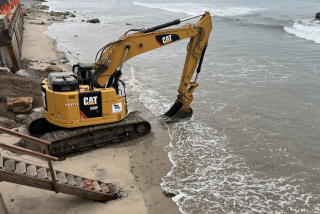Judge Orders Removal of Jetties : Environment: Neighborhood association has been told to dismantle dangerously eroded steel pilings at Las Tunas Beach. The barriers have been the focus of legal wrangling for 14 years.
After 14 years of legal wrangling, some dangerously eroded steel sheet pilings that threaten surfers, joggers and swimmers at Las Tunas Beach in Malibu may finally be headed for the scrap heap.
Los Angeles Superior Court Judge John Zebrowski has given a neighborhood association 30 days to apply for a Coastal Commission permit to remove the pilings, known as groins. Most of them are on private property.
The order is the latest twist in a legal tempest that has involved the state of California, 92 homeowners, 30 lawyers, 12 insurance companies and litigation costs approaching $10 million.
Zebrowski’s order, issued earlier this month, was aimed at nudging a beachfront property owner group, mired in dissension, to dismantle the jetties, which all agree have become a public hazard.
“We’ve had an agreement for over 2 1/2 years that the groins would be removed, but they have just kept diddling and diddling,” said Jim Strout, an assistant executive director for the State Lands Commission. “We just want to get the hazard out of there.”
The 13 groins vary in length from 80 to 455 feet and were constructed in 1929 by the Title Insurance and Trust Co., now Ticor, to build up sand near a series of Malibu beachfront lots, thus protecting them from erosion. The groins, which run from the beach into the surf, resemble thin metal gates with some encased in corroding concrete.
However, in the early 1980s, two joggers, on separate occasions, cut themselves on the exposed sheet metal and sued the state. Both settled out of court for about $30,000 each.
In 1981, the state sued Ticor, which in turn sued a group of 92 property owners as co-defendants, to repair the groins. The state threatened to remove the jetties unless they were repaired.
The suits resulted in a storm of litigation among neighbors, their insurance companies and Ticor. Debate centered on who was responsible for the jetties, whether they should be eliminated, and, if so, whether they should be replaced.
In 1989, the parties reached an agreement mandating that Ticor contribute $2.15 million, and the insurance companies $400,000, to build eight bulwarks, known as “rubble mounds,” over eight of the eastern groins at Las Tunas. The state agreed to tear down the remaining five western jetties.
However, the bulwarks have not been built. Roughly one-fourth of the area’s 92 property owners vigorously contested construction of the bulwarks because they believed the groins should have been removed in the first place.
“They are dangerous and should be permanently removed,” said Fay Singer, a self-proclaimed “Ph.D. in groins,” and a resident leading the anti-jetties fight. “The groins haven’t provided any erosion protection for years--they’re like a fork; sand is flowing right through them. If they’re taken out, the beach won’t be any worse than it is now.”
Others, particularly surfers, worry about the detrimental effects the eight bulwarks could have on the waves at Topanga Point beach.
“The spot has a delicate equilibrium of cobblestones coming from the mountains and rocks and sand coming down the beach, which make for a special wave,” said John Hearne, an official for the Surfrider Foundation. “Expanding these groins will be an environmental abomination, and could severely affect the sand flow to (Topanga) Point.”
*
Still, a majority of homeowners believe some safeguard is needed lest their houses float out to sea. The group hired Moffat and Nichol, a coastal engineering company, which provided a study of the area’s erosion and a proposal for the construction of the bulwarks.
“If I lived there, I wouldn’t feel comfortable without some type of shore protection,” said Bob Nathan, an engineer for Moffat and Nichol. “That beach is an eroding beach, and I wouldn’t have a warm and fuzzy feeling watching the waves break right outside my window.”
The beach property owners had formed a Geologic Hazard Abatement District, known as GHAD, under the auspices of the Malibu City Council to proceed with the work and limit individual homeowner liability. The Coastal Commission granted a permit to homeowners in July, 1991, to begin the bulwark project.
A few years ago, Malibu hired an engineering firm to review the project. That review created doubt about the project’s feasibility, and council members ordered that the district be disbanded and the bulwark project be shelved.
In November, 1993, the Coastal Commission refused to renew GHAD’s building permit, citing the political dispute between the homeowner group and the council and other environmental issues raised by the Surfrider Foundation.
Linda Hauser, a spokeswoman for Craig Dummit, an attorney representing a majority of the Las Tunas property owners, said Dummit intends to comply with Zebrowski’s order and tender an application for the removal.
More to Read
Sign up for Essential California
The most important California stories and recommendations in your inbox every morning.
You may occasionally receive promotional content from the Los Angeles Times.









